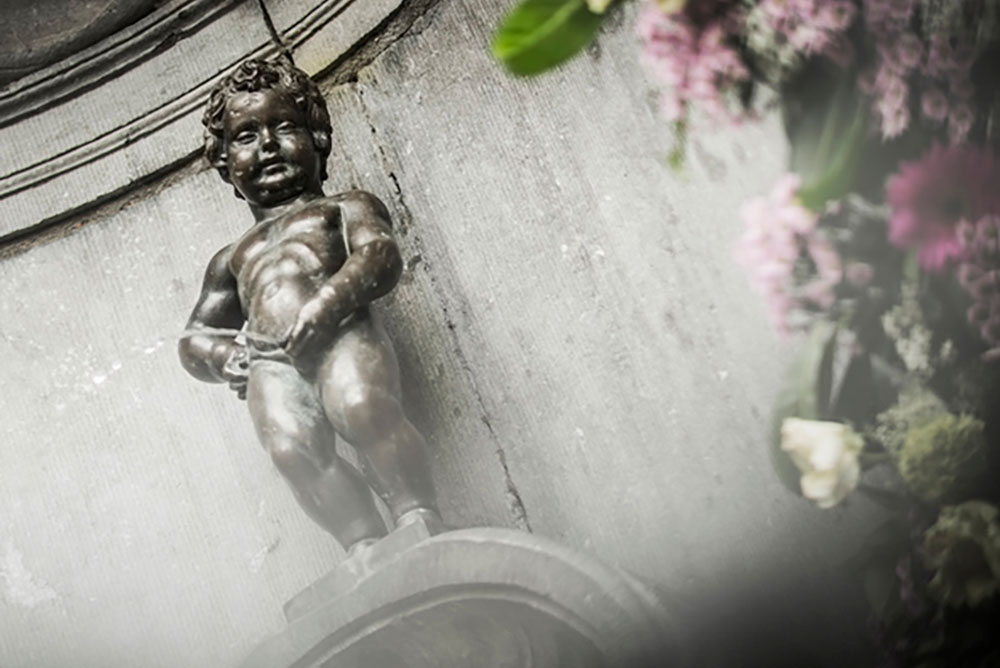
The famous “Manneken Pis” statue in Brussels, Belgium. iStock photo.
By Stephanie Cavanaugh
FRANKLIN STOOD UP from the dining table and announced that he was going outside to pee.
This was not something I needed to know.
Suzanne has several perfectly fine bathrooms in her country place, but Franklin said he never pees indoors.
I had just met him and already he was off my future guest list. Imagining him standing on the back porch watering the ferns and whatnot. No.
Now I find that judgment may have been too hasty. The ferns might have benefited from a spray of nitrogen, phosphorus and potassium, key components in the finest fertilizers and key components in human urine.
Fancy that.
A couple of weeks ago, in the New York Times, there was a photo of what looked like a baby car seat. Not the plush kind you see today, but the kind I hauled my baby around in 30-odd years ago. Basically, a lightweight molded plastic bucket that would sit jammed behind the gear shift on our old Porsche, where I could fling an arm across her as further restraint, if necessary. It could also be lugged into restaurants to prop her up at the table. A handy, if entirely unsafe item.
But did we know any better? Nope. Amazing that she lived.
Right. So this baby car seat is geranium red, or maybe crimson, a very bright red, Santa Claus red. It’s attached to a pipe that runs into a box of some sort on the floor, and then the eau, shall we say, is channeled outside the house and into a holding tank. It’s called peecycling.
Did I mention that this is a very large bucket, shaped for adult rumps, if one sits to go?
If the ground is really wet, one can just dilute the family drippings, so you don’t burn the begonias, and then directly douse the garden. Alternatively, and more commonly, not to mention safely, the pee pails are collected and taken somewhere by someone (this part is a little unclear) to be pasteurized.
Says the Times: “ ‘Human waste is already being used to fertilize foods you find in the grocery store,’ said Kim Nace, a co-founder of the Rich Earth Institute, which collects the urine of some 200 volunteers in Vermont . . . and teamed with the University of Michigan on a process to make a sanitized pee concentrate.”
The results of various trials have been remarkable. Water use is dramatically reduced, the need for chemical fertilizer is nearly eliminated, and the crop growth is spectacular. In rural Niger, where an experiment has been underway, pearl millet, the staple crop, has increased by about 30 percent.
Lest you think such a movement is confined to places like Vermont and West Africa, the Times continues, “In Paris, officials plan to install pee-diverting toilets in 600 new apartments, treat the urine and use it for the city’s tree nurseries and green spaces.”
So there.
As My Prince is the one who pointed out this germ of an idea, I’m frankly surprised that one of these pots hasn’t turned up in our house since the story appeared. He has a habit of latching on to such appealing notions, like the slop bucket in the garden that he delivers to the farmers market each Saturday with a week’s worth of potato peelings, avocado pits and corn husks, which is transformed into compost for someone else’s plants.
Interesting thought: We don’t need a powder room, we could just pass guests a bucket . . .
Or, if it’s raining, just send them outside to pee off the porch.

Jelly fish stings too, Maggie!
Thank you Stephanie….at last confirmation of a couple of things from my family memories: when my brother (many years ago one June) had his 21st birthday party, in our one lavatory home, the guys all went into the garden to pee. My father said, well at least we’ll have a splendid show of roses this summer – and we did! A few years earlier my Scottish grandmother (who’d now be 140) loved telling us how the best way of curing sore/blistered hands was to pee on them. Maybe her tale was not a myth. Also, since first visiting Brussels as a teenager, I have a small collection of Manneken pis souvenirs. Now, thanks to your “peecycling” story I have a nurturing yarn to go with them….
Well… something to ponder of course we all know that fertilizer stinks for a reason.